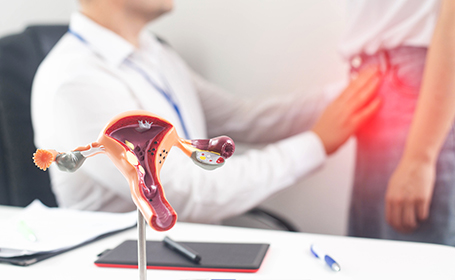
5 things you didn't know about uterine fibroids
Uterine fibroids are an extremely common gynaecological condition A staggering 80% of women will develop uterine fibroids by the time they have reached the age of 50. They can cause distressing symptoms such as chronic pelvic pain, heavy periods and pain during sex. We look at five things you might not know about uterine fibroids, exploring important information about the condition including procedures to shrink uterine fibroids and how menopause affects fibroids.
1. Uterine fibroids are non-cancerous growths
Uterine fibroids are benign or non-cancerous growths that can develop in or around your uterus (womb). Uterine fibroids are formed of muscle and fibrous tissue — these growths can vary in size.
The NHS states there are three main types of uterine fibroids. Intramural fibroids are the most common type of uterine fibroids. These can form in the muscle wall of your womb.
Subserosal fibroids are fibroids that develop outside of your womb’s muscle wall.
The third type of fibroids are submucosal fibroids. These develop under the inner lining of your womb.
2. Most women do not experience uterine fibroid symptoms
Surprisingly, most women with uterine fibroids are often unaware that they have fibroids, because they do not experience any symptoms. According to the NHS, only one in three women with uterine fibroids may experience symptoms. Uterine fibroid symptoms include heavy or painful periods, lower back pain and abdominal pain. If you have uterine fibroids, you might also experience an increased urge to urinate, constipation or discomfort during sexual intercourse.
On rare occasions, fibroids can affect your fertility or lead to complications during pregnancy. Fibroids can affect your fertility by preventing sperm from reaching and fertilising your egg. Or, fibroids can prevent a fertilised egg from attaching to your womb’s lining. But the NHS states this is a rare occurrence.
If you have a submucosal fibroid, it can block your fallopian tubes. During ovulation, your ovary usually releases an egg every month, which travels down your fallopian tube. As your egg travels down your fallopian tube, it can be fertilised by sperm or reabsorbed by your body. However, a blocked fallopian tube can make it difficult for your egg to travel down your womb and become fertilised. This can affect your fertility and make it harder for you to become pregnant.
Only one in three women with uterine fibroids may experience symptoms.
3. What causes uterine fibroids?
What cause uterine fibroids? Uterine fibroids are associated with having high levels of oestrogen (a female reproductive hormone) in your body. Your oestrogen levels are at their peak during your reproductive years (when you are aged 16 to 50). During these years, you are more likely to develop fibroids. However, after menopause (when your period usually stops between the ages of 45 to 55) fibroids tend to shrink as the level of oestrogen in your body falls.
4. There are procedures available to shrink symptomatic uterine fibroids
Fibroids often shrink and disappear without the need for treatment. Especially, after you’ve gone through menopause. But, if you have persistent systems, your GP may prescribe you gonadotropin releasing hormone analogues (GnRHas) to shrink your fibroids.
GnRHas are hormonal injections. They can help with symptoms such as heavy or painful periods from uterine fibroids. GnRHas work by preventing your ovaries from releasing oestrogen and stopping your menstrual cycle. These hormonal injections can also improve other symptoms induced by uterine fibroids, such as constipation.
Another medication taken to treat uterine fibroids is ulipristal acetate. This is only prescribed for short-term use and if your uterine fibroids are causing moderate to severe symptoms. Your GP will also only prescribe ulipristal acetate, if other surgical or non-surgical procedures have been unsuccessful or are unsuitable for you. This is due to the risk of serious liver damage and liver failure that is associated with ulipristal acetate.
5. Uterine fibroid removal: a hysterectomy is the most effective way of preventing fibroids from returning
The NHS reveals having a hysterectomy is the most effective method of preventing fibroids from returning. A hysterectomy is a major surgery that involves the removal of your uterus (womb). Your GP may recommend a hysterectomy if your fibroids are large in size. A hysterectomy may also be advised if you suffer from severe bleeding, and do not plan to have more children.
It typically takes six to eight weeks to recover from a hysterectomy. It is recommended that you avoid any heavy lifting during your recovery.
Although, a hysterectomy is the most effective method of ensuring your fibroids do not return, an alternative treatment for uterine fibroids is a myomectomy. If you plan to have children, your GP may recommend having a myomectomy instead of a hysterectomy.
A myomectomy involves the surgical removal of fibroids from your womb’s wall. This is typically performed through small cuts on your abdomen or through a larger incision. The NHS states a myomectomy is not recommended for all types of fibroids. A gynaecologist can help determine whether a myomectomy is an appropriate surgery for you — this will be decided based on the location and size of your fibroids.
Tags
How do I book an appointment?
If you're concerned about symptoms you're experiencing or require further information on this subject, talk to a GP or see an expert consultant at your local Circle Hospital.